75 Years of DC Comics: The Paul Levitz Interview
Jul 26, 2010
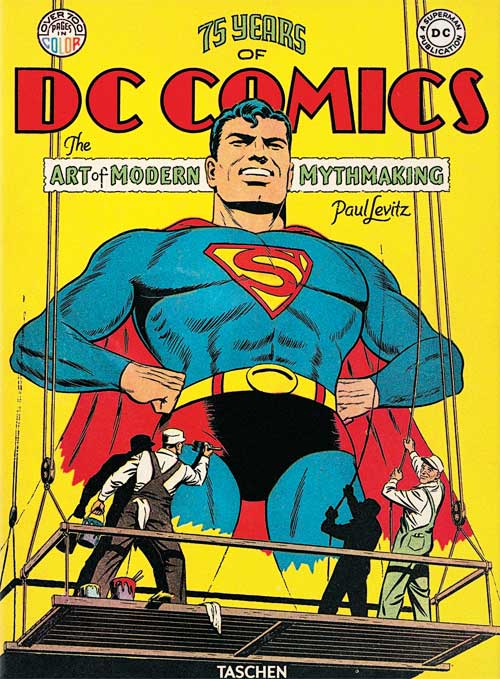
|
This year, 2010, is the year of Paul Levitz’s “homecoming” with a very well-received return as a writer to the Legion of Super-Heroes, as well as June 2010’s Batman/Superman Annual and Adventure Comics. In adding “historian” to his repertoire, Paul Levitz is writing November’s massive 75 Years of DC Comics: The Art of Modern Mythmaking, published by art-world giant TASCHEN and filled with over 600 pages of rare and never-before-seen photography and artwork.
If the present is any indication, Paul Levitz may have stepped away from DC’s top chair, but he certainly hasn’t turned in his keys to the executive lounge. Writer, editor, and publisher, Paul Levitz has been active through two ages of the comic book industry, and over 35 years of working within DC Comics. He’s become one of those special figures in an industry: a living legend.
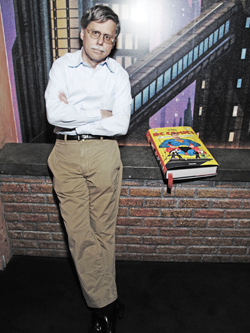 This month, we were able to get some unique perspective about the business from Paul Levitz and get his thoughts on the history of DC Comics, his history with DC, the experience of returning to familiar territory, and the evolution of the industry.
This month, we were able to get some unique perspective about the business from Paul Levitz and get his thoughts on the history of DC Comics, his history with DC, the experience of returning to familiar territory, and the evolution of the industry.
**********
Jamal Powell: Let me thank you for the opportunity to interview you, and congratulations on your well-received return to writing with Legion of Super-Heroes #1, as well as the Superman/Batman Annual #4 and Adventure Comics #12; Comic Nexus gave Legion of Super-Heroes #1 a 9/10 review, a rating they rarely give...
Paul Levitz: I’ve been very happy with a lot of the reviews and a lot of the ratings it’s gotten. It’s been a very warm welcome back. You’re always nervous in a situation like that where you’re being sent off to play in the “old timer’s game,” and they’ve welcomed me back onto the field.
JP: You’ve made a successful return to writing with Superman/Batman Annual #4 and Adventure Comics #12 and you’re already encountering critical praise and high sales with Legion of Super-Heroes #1. How does it feel to be back on the book that made you famous?
Levitz: It’s like hanging out with old friends again in a lot of ways. These are characters that I liked as a kid, and that I had a lot of fun writing. So it’s a very natural place to be. Catching up with people’s lives after awhile, that’s part of the fun of it, too.
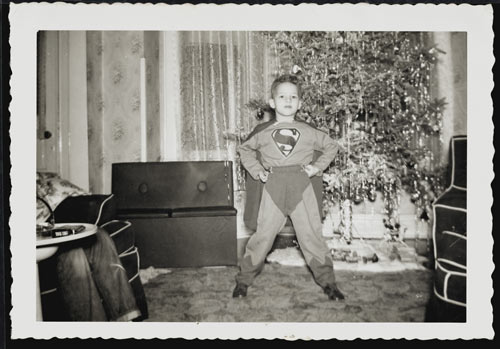
|
JP: How has writing evolved?
Levitz: There’s a lot of theatrics that are different. There’s a general discomfort with thought balloons, and a general preference with using voice-over narration captions, that kind of flips from one tool to another. The heavier narrative caption, the kind of thing I used to use for the Legion as Encyclopedia Galactica, those things are pretty interesting to try on with the different tools. One of the more interesting changes I think is the assumptions about the audience and how the world connects now. I find myself very conscious that the audience is on average older, better educated, better informed, and much harder to stump. So you can put things in that are Easter Eggs to the mythology of the book and say “Hey, if you get it in context that’s wonderful”, or if you know there’s something there, but you don’t really remember what it is, it leads you to explore, and that’s not so tough. As long as it doesn’t stop the flow of the story. And I think that will expose some new material from the mythology as well and things that come from the real world. I had the occasion in either the first issue or the second issue to have Brainiac 5 make a crack about Maslow, and I would have been enormously nervous to have him do that the last time I was writing the book. But now, if you already know about Maslow’s hierarchy of needs from your college education, that’s terrific, if you don’t know, it probably was a clear line in context, and if you’re curious, it takes you 3 seconds to Google it and learn something. That’s a different kind of dynamic in many, many ways.
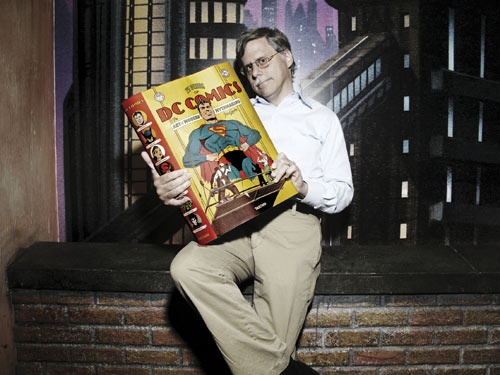
|
JP: What methods do you take to ensure that storyline and dialogue within the Legion of Super-Heroes appeal to a modern and mostly teenage audience?
Levitz: You just try to make the story appealing and try to do your best work.
JP: In addition to writing books for ensemble teams such as the Legion of Super-Heroes and the Justice Society, you've served as editor on solo books such as Batman and you are credited with creating Earth-2's Huntress. Having worked on many characters in almost every capacity at this point, which characters would you want to work on most and what role would you serve in their creative process?
Levitz: I’m very open-minded on that, the fun comes from what you’re doing at the moment. I had a great time as an editor in the years I spent doing that, I’m not anxious to go back and do that moment of my life again. I had one of the great jobs on the planet as the publisher of DC for a couple of decades; I don’t think I’m going to go back to a job, doing anything like that ever again. I probably won’t do a regular job again. So the challenges for me are, as a writer, what’s available for me to work on, what kind of projects can I generate, and what’ll be the next fun thing to do?
JP: During your tenure as president, what were some things you are proud to say that you were the mind behind it?
Levitz: I don’t really separate the time in which I was president of the company, because in my head at least, I’ve had a long association as part of the team that was leading DC under four or five different job titles. It’s a continuity of process, and maybe it’s nostalgia, but I think some of the things that were most important went on very early on in that, such as the crafting of the royalty plan. For comics, it was the first time a major publisher did a royalty program which included all of the books and all of the talent. There were a lot of things we did to build the distribution side of the business, including organizing a “sales agency” kind of agreement with Diamond that we worked out in 1995 during the “Time of Troubles”, if you want to call it that, when the distribution system was up-ended. It’s been a lot of years, and a lot of stuff that was fun to work on. And of course, it’s been a long and happy road.
JP: This year, there are a few comic book milestones being celebrated, with 2010 being DC's 75th anniversary. DC is celebrating this milestone in several unique ways, such as DC's release of variant covers which are all re-drawn covers of important DC comics; the cover of your own Legion of Super-Heroes #294 was re-drawn by Lee Bermejo. What made you decide to create 75 Years of DC Comics: The Art of Modern Mythmaking as part of your tribute to DC Comics?
Levitz: The idea of being a large-scale, coffee table celebration as part of the 75th was one of the earliest cornerstones when we were talking about the anniversary because it’s kind of a natural time to look back and commemorate the enormous wealth of creativity that’s been developed over the years. When the project first started, I was asked to write it, but I was still doing the desk job, and didn’t feel I could remotely devote the time and energy necessary to writing it. As DC was casting around for a writer, then as circumstances developed, I was stepping away from the desk job; they still hadn’t found anybody, so I said “Ok, that would be fun, I’d be happy to have some fun with that.” It’s been a fascinating project.
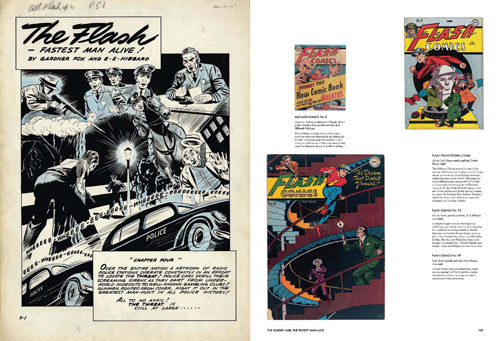
|
JP: How long have you been working been working on 75 Years of DC Comics: The Art of Modern Mythmaking?
Levitz: As a writer, probably from September 2009.
JP: So the research process has only taken place from September 2009 to the present?
Levitz: We’re still in the research process on some things, but then you find a cool illustration. The guys found a terrific little photograph of Mike Sekowsky during the time where he was doing Wonder Woman in plain clothes, and Mike is in the office sketching a model dressed in the style that he was going to work with for Wonder Woman, and a number of people are saying to themselves “I think I know who that is, but I can’t place the woman’s name…” So everyone’s running around, trying to figure that out. That’s kind of the small-scale research, but the research will go on until the book goes off to the printer because we’ll be trying to dot the lost “i’s” and cross the lost “t’s”.
JP: What were some of the research methods you've used in gathering 75 years of oral, verbal, and written history of DC Comics? Was it difficult to gather all of the artwork and photography?
Levitz: TASCHEN has been astounding in their pursuit of the artwork and photography. They sent one of their teams to the U.K. to photograph one of the great collections of DC material; they came to get fresh photographs of high-quality books, they went through their archives looking for anything that relates to comic books that few others have ever seen, and they’ve certainly gone from top to bottom in whatever stuff has survived at DC or in individual collector’s hands. I think that the selections within the visual dimensions of the book — and I think there’s around 1.500 illustrations in the book — there’ll be things that no matter who you are, you won’t have seen something before. You’ll crack a smile.
JP: TASCHEN is one of the world's premier publishers of art books, having released many controversial but critically and commercially successful works. Why did you decide to publish The Art of Modern Mythmaking through TASCHEN?
Levitz: Well, when you make a decision like that, you’re looking at the skill of the publisher. I always make the argument, whether it’s for a writer or anyone else, if you’ve got an idea for a project, go out and see what it would fit with and who does this kind of thing well. And TASCHEN has an extraordinary track record of doing visually beautiful books on very eclectic subjects, so they’ve been able to dive in and take photography, make it spectacular and things like the Muhammad Ali book they did a few years ago, that allowed them to run with popular culture. They have a fabulous book that they’ve done on circuses, which is actually about the same size as The Art of Modern Mythmaking, which was strained with material as well a lovely book on magic which is also about the size of The Art of Modern Mythmaking, and they’ve made that stuff work very effectively. TASCHEN was always on the very short list of possible publishers for the Art of Modern Mythmaking, and when you consider the possibilities further, the founder of TASCHEN is a comics fan that started his business with comics-related publishing, coming out of a comics shop that he owned in Germany many years ago. So he had sympathy for the material, and from my own experience I can only say that if a publisher supports a project, that’s a good thing.
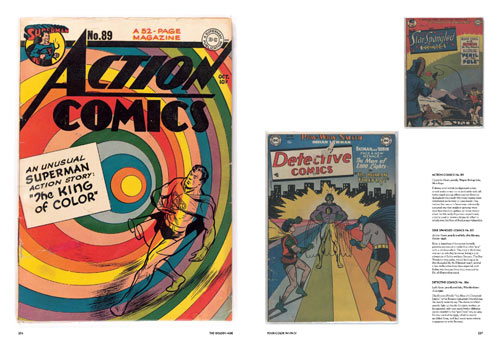
|
JP: What has it been like working with TASCHEN? Have they brought anything unique to The Art of Modern Mythmaking?
Levitz: They’ve brought lots of unique visual resources to the process; they’ve found stuff under rocks and we didn’t even know where the rock was, much less what was under it.
JP: For you, what would be the most single most significant event, period, or era within DC Comics' 75-year history?
Levitz: Well, there’s an old saying for science fiction that I attribute to a couple of sources, but the saying is “The Golden Age of Science Fiction is 12”. But I think that applies to all forms of popular culture, including comics. So for me, there’s a certain magic about the material that was coming out in the late ’60s, when I was just old enough to understand writer and artist credits. I was just tapped-in enough in comics to know from fanzines what might be happening next, and I started looking around the curve, and I started to develop my own sensibilities. The excitement that was possible for me at that moment, maybe it was how old I was and how receptive I was, or it may objectionably be a great moment in the company’s history, but I think you have a certain bias to the material that you bring from your own life.
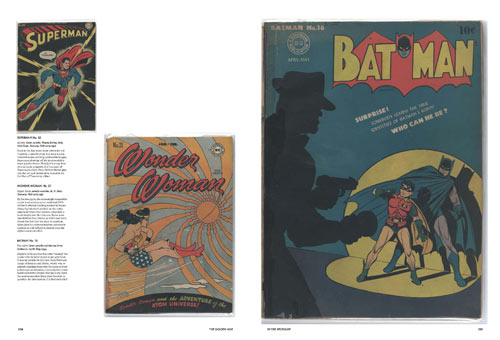
|
JP: What, more than anything, can fans expect from 75 Years of DC Comics: The Art of Modern Mythmaking? What are some the features that will really make this a must-buy for comic-book history buffs?
Levitz: I think that the must-buy part of it is that the vast majority of the comic publishers these days go back and tell the same story but with a little added detail, just sort of telling the basics of the tale. And if you’re going to do a book published with the ordinary length with the ordinary number of illustrations, if you’re doing Marvel Comics, you have to have the cover of Amazing Fantasy #15 in there, you have the have the cover of Fantastic Four #1 in there, what do you have in there that is totally unexpected and how much room do you have for the unexpected on top of what’s regular? An enormous part of the power of this book is its sheer damn size! I was doing a publicity shoot with a dummy of the book in my hand and that thing weighs a ton! So we’ve really got room to explore visuals that you haven’t seen before; whether those are sketches or unpublished material; photographs of behind-the-scenes processes… I saw a photo the other day that was being considered for the Silver Age section that when I looked at it carefully, I said “That’s Murray Boltinoff and Arnold Drake at the separation plant in Bridgeport, CT at the time when Arnold was writing the Doom Patrol. And there are a couple of guys with them, and I think one of them is Bruno Premiani, but I’m not sure. To capture a moment like that, which has not been seen by a fan of that moment — and like I said, that ties into my 1960s passions — is a wonderful thing. There are photos from the 1940s, the 1980s; there are pieces of work that have survived, and hopefully, if I’ve done my job in the narrative section of it, there will be small facts that will have been added to the history that people won’t have had the opportunity to know or that you would have had to be incredibly versed in the history of comics to remember off-hand but will be woven into the narrative.
JP: In having served so many prominent roles in DC Comics during your 35 years with DC, how do you feel that experience has impacted the content of The Art of Modern Mythmaking?
Levitz: Howard Chaykin makes the remark of our generation of talent in the business: “We came in at the end of the beginning”. We got there in time to hear the story of how comics started from the people who started them. I’ve actually been at DC now almost 38 years, and I was hanging around the business as a fanzine editor in New York for several years before that, so I’ve lived through, on one level or another, half of those 75 years, known the people, and if I’ve done my job right somewhat, I’ve observed in their personalities and the interesting moments in their lives, which should come through in the work and give some sense of evolution. The narrative is only about 32,000 words, which is about 3 quarters of a word per comic DC published, which is not nearly enough to give justice to all of the people and all of the comics as well as all the fascinating ideas and movies and TV shows that came out of it.
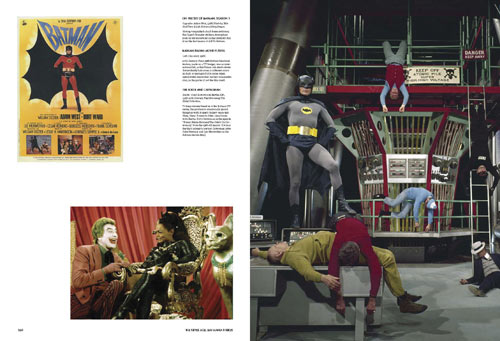
|
JP: Can fans expect "insider" history that they've never been privy to before?
Levitz: There’s insider stuff in the sense of “learning the secrets behind the comics” such as “This is the day when…” we don’t really have the length for a lot of that, and the inside-baseball stuff of it tends to be most important to the fan who understands all of the context in this book is being written to make sense both to the fan and to the person who loved a character when they came to television. There wasn’t room for a long discussion about Doom Patrol and why it started with #86 rather than issue #1; that probably isn’t the “magic trick” for a book like this but there’ll be things in the book, I think, that many fans didn’t know before and will find interesting.
JP: Earlier, we asked how you felt storytelling in comics had changed from when you were previously active as a writer to 2010. As a DC historian, how do you feel that comic-book storytelling has evolved overall from 1935 to 2010?
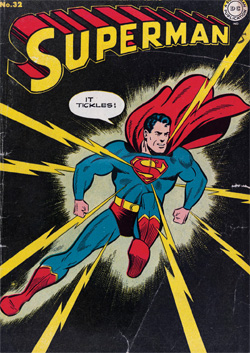 Levitz: Comic book storytelling in 1935 was a very primitive thing; most of the comics written in 1935 were one or two-page stories. That’s the equivalent of saying “how did writing evolve from the telling of an anecdote and a book of the size and complexity of The Lord of The Rings?” You couldn’t do Lord of the Rings in an interesting fashion in 300 words; there’s more than 300 names in the book. The growth and the size and the sophistication of the medium has created tremendous possibilities, the way that the kind of stories being done and the genres explored, the presumed audience, the original comics were written very simply for the kind of casual readership that the newspaper strips had in America. Now many comics are done for people intensely involved with them… not necessarily from a continuity standpoint, but people who are willing to commit themselves and put their passion into a book. When Joyce wrote Ulysses, he said “This is the way to tell this story, it’s going to be a lot of work for a reader, and the reader who wants it will enjoy it and will stay. And if they don’t — the heck with them.” That potential has grown to exist in comics and has just begun to be fully explored in America.
Levitz: Comic book storytelling in 1935 was a very primitive thing; most of the comics written in 1935 were one or two-page stories. That’s the equivalent of saying “how did writing evolve from the telling of an anecdote and a book of the size and complexity of The Lord of The Rings?” You couldn’t do Lord of the Rings in an interesting fashion in 300 words; there’s more than 300 names in the book. The growth and the size and the sophistication of the medium has created tremendous possibilities, the way that the kind of stories being done and the genres explored, the presumed audience, the original comics were written very simply for the kind of casual readership that the newspaper strips had in America. Now many comics are done for people intensely involved with them… not necessarily from a continuity standpoint, but people who are willing to commit themselves and put their passion into a book. When Joyce wrote Ulysses, he said “This is the way to tell this story, it’s going to be a lot of work for a reader, and the reader who wants it will enjoy it and will stay. And if they don’t — the heck with them.” That potential has grown to exist in comics and has just begun to be fully explored in America.
JP: How has the industry of comic books itself evolved from 1935 to present?
Levitz: I’d argue the two main axes you can answer that question on: one is the product itself, which has gone in business terms to three product life-cycles. It started out as an inexpensive casual purchase with very low commitment from the readership and the people selling it. It’s become a “shopping good” that people now think about and they invest a fair amount in their choices and how they make a purchase. They care about it deeply and are willing to go further to buy it; they have a much more complex mental shopping checklist as far as what virtues they expect from the work as a result, and that whole cycle has tremendously effected the kinds of comics that are produced, created, and ultimately sold. And the other axis is the relationship with the creative talent. The original comics in America were produced in very much a factory kind of system. It was “we’ve got twelve seats in the bullpen and it really doesn’t matter who’s sitting in them each day.” No one had an economic stake in their own creativity; as we’ve happily evolved to where the creative talent has a very significant economic stake in their own work. The investment that they’re willing to make, the creative risks that they’re willing to take, and the thought that they put into their work has grown enormously, and I think that’s the great arc of change within the business over the last 75 years.
JP: What part of creating The Art of Modern Mythmaking was the most fun for you?
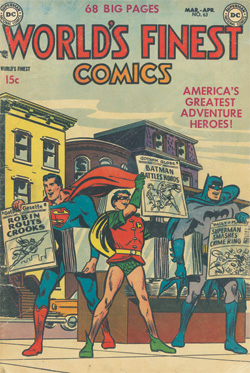 Paul Levitz: Finding the weird stuff! This has all been part of my life, so going back and finding the an old article that Lloyd Jacquet wrote 50 years ago that I had pulled out from a fanzine and thrown in my files. He talks about the printing of the first issue of the first DC, New Comics #1. I haven’t thought it about for years since, but now I read it and think “Oh yeah, the first DC was printed in Brooklyn, where I was born, at the Brooklyn Eagle? And that’s why it was in black and white and not in color like all the other early comics that Max Gaines was doing over at Eastern Color? Ohhhh, that’s why it’s like that!” And that wasn’t an unknown fact, in the sense that it was in was in a fanzine article from 20-30 years ago or even this article that was published 50 years ago, but to me it was a “lost” fact, and then here and there we find things that genuinely are completely unknown.
Paul Levitz: Finding the weird stuff! This has all been part of my life, so going back and finding the an old article that Lloyd Jacquet wrote 50 years ago that I had pulled out from a fanzine and thrown in my files. He talks about the printing of the first issue of the first DC, New Comics #1. I haven’t thought it about for years since, but now I read it and think “Oh yeah, the first DC was printed in Brooklyn, where I was born, at the Brooklyn Eagle? And that’s why it was in black and white and not in color like all the other early comics that Max Gaines was doing over at Eastern Color? Ohhhh, that’s why it’s like that!” And that wasn’t an unknown fact, in the sense that it was in was in a fanzine article from 20-30 years ago or even this article that was published 50 years ago, but to me it was a “lost” fact, and then here and there we find things that genuinely are completely unknown.
JP: If DC's past history is any indication of the future, where do you see DC Comics in five years and beyond?
Levitz: If you had asked me when I came into the comic business in the early 1970s to envision a world in which comic book publishers were publishing four volume sets of books like The Sandman and readers were cheerfully paying a total of $400 bucks for that, I’d have had you committed. Neil Gaiman had been a passionate advocate of doing a project like that for 5 to 10 years before we did it, and every time he came in to pitch the project, I would either laugh him out of the office or gently cajole him out of the office saying “The world’s not ready for it yet, Neil.” Neil’s vision was correct; I don’t know if the world would’ve been ready for it before DC chose to do it, maybe a little bit earlier, not a lot. But there it is now, and now there’s bodies of works being produced that way and doing large volumes of sales. If you’d have asked me ten years ago if it was possible to sell 1,000,000 copies in a year of a graphic novel that was 20-years-old, I’d say “I don’t know how.” So I’m not going to look forward to the next 20 or 30 years and claim the ability to prognosticate where this all going to end up. Certainly we’re going to live through a digital revolution; we’ll see how the next generation likes getting their comics, whether they want them in print or digitally-printed; if they want some new form of comic created just for digital consumption. That’s going to change and evolve, the kind of stories are going to change and evolve, we’ve just begun to have the freedom in America to tell something resembling the wide range of stories that are told in Japan, France, and the rest of the world. It’s hard to define where the hell it’s going, but it sure looks to be an interesting ride!
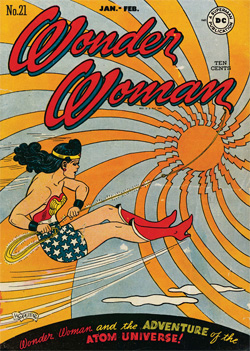 JP: What are some of the unique insights into the history of DC Comics that you feel The Art of Modern Mythmaking offers to fans? What kind of understanding of DC history do you hope the readers will gain from these insights?
JP: What are some of the unique insights into the history of DC Comics that you feel The Art of Modern Mythmaking offers to fans? What kind of understanding of DC history do you hope the readers will gain from these insights?
Levitz: I think they’ll be able to see enough of a sampling of the history of DC to get a sense of the enormous breadth of it. The last time anything like this was done was 15 years ago. Even though the history was shorter, the book was so much smaller that on many of the subjects, if you got one illustration in, that was it. You didn’t get the stock illustration, but the most likely illustration. Here I think you’re going to see a large range of material that will enhance your sense of how all the pieces of the puzzle come together.
JP: There’s a buzz building on the new Legion of Super-Heroes. What can readers expect within the next few months?
Levitz: I think there’s a few surprises in store, even within the next few issues. Issue #5 finishes up the basic arc of “Earth Man’s Choice”, and the cover to #6 is somewhat the punch line to that story as we move into its epilogue, and I think it’s just a very beautiful and very unexpected moment, and hopefully one that the fans will have a fair amount of energy arguing about!
JP: On the behalf of Previews, I’d like to thank you for taking the time to talk to us and I wish you luck on the Legion and your other works in the future.
Levitz: Thanks, I appreciate your efforts. Take care.
************************
Jamal Powell is an intern for Previews this summer, an independent comics writer, and a lifelong comics fan, who lives in Baltimore, MD.




